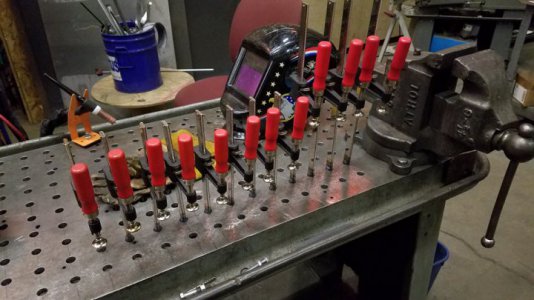- Joined
- Jun 10, 2019
- Messages
- 537
I have a table which I plan on drilling fixture holes into (similar to what @jmkasunich did in this post) and had a couple questions about factors to consider related to the hole sizes and spacing.
Each measurement system has a smaller and larger config:
Metric: 16mm at 50mm spacing; 28mm at 100mm spacing
Bananas: 5/8" at 2" spacing; 1-1/8" at 4" spacing
In some cases I've seen some imperial tables feature metric holes (e.g. 16mm at 2" spacing).
My Q's:
My table top is 6'x4', 1" thick steel. I'm leaning towards metric holes and a multiple of the standard spacing for now; I figure I can drill the in-between holes in the future if need it.
Each measurement system has a smaller and larger config:
Metric: 16mm at 50mm spacing; 28mm at 100mm spacing
Bananas: 5/8" at 2" spacing; 1-1/8" at 4" spacing
In some cases I've seen some imperial tables feature metric holes (e.g. 16mm at 2" spacing).
My Q's:
- Do commercially available fixturing tools work with either size class? Or is the tooling specific to the hole size? I realize things like dowel pins would need to be exact fit, but do dogs and the expanding ball-bearing types of fixture pins fit both inch and metric holes?
- Does one hole size system (metric vs. inch) have better tooling availability?
- What would go into deciding between the smaller vs. larger holes and spacing (other than the effort of drilling more/less holes)? Should the spacing match the table size? Are fixtures more generally available in the larger spacing or hole size? etc...
- Is it worth considering a mix of bored and tapped holes?
My table top is 6'x4', 1" thick steel. I'm leaning towards metric holes and a multiple of the standard spacing for now; I figure I can drill the in-between holes in the future if need it.



